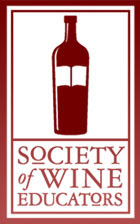 What has always fascinated me is how wine "critics" go about assessing the so-called quality of a wine. There is the ever-popular, often-vilified 100-point system, which really isn't a 100-point system, but a 50-point system, as well as the 20-point system, which is usually employed at Wine Festivals like our local Cincinnati International Wine Festival (of which I have been a judge the past two years). To employ one of those scales is in a lot of ways, taking both the joy and the artistic expression of the wines. Granted, there is a lot of plonk out there (as evident I found during my last two stints at the CIWF), but ultimately, every winemaker is after some sort of expression, much like a poet, a songwriter, a painter, or any other type of artist.
What has always fascinated me is how wine "critics" go about assessing the so-called quality of a wine. There is the ever-popular, often-vilified 100-point system, which really isn't a 100-point system, but a 50-point system, as well as the 20-point system, which is usually employed at Wine Festivals like our local Cincinnati International Wine Festival (of which I have been a judge the past two years). To employ one of those scales is in a lot of ways, taking both the joy and the artistic expression of the wines. Granted, there is a lot of plonk out there (as evident I found during my last two stints at the CIWF), but ultimately, every winemaker is after some sort of expression, much like a poet, a songwriter, a painter, or any other type of artist.The difference between rating wines and assessing their market appeal are two entirely different animals, if only in the fact that you have to look at the wine's QPR (quality-price ratio) and any other nuances that might be appealing to consumers - like limited availability or direct import or regionality, there are a host of variables.
Buying by the numbers is almost an inherent indication that the buyer (for a wine store, restaurant, etc.) is without any real palate or knowledge of their own. It's something I have learned over the years, thanks in large part to a great many individuals I have come to respect and admire - not only for their palates, but for their passion and desire for this business and for wine itself. My buddy Eric Jerardi was one who I feel unintentionally coerced me into exploring my own palate as I was building my first wine list at Cafe Boulevard in Dayton, Ohio (while I was bar manager there). People like Mary Kay at The Winds in Yellow Springs and the late, great Doug Simon of Arrow Wine & Spirits, who had a fairly innovative approach to how they selected wines for their respective stores. So many people I have met and worked either for or with over the years, have contributed to my own wine education, and I continue to learn each day.
Yet it is ironically, the artist in me that seeks out the unique, artistic expression in a wine before I really consider it for the store. As far as the scores go, I am unimpressed. The worst thing a winemaker or an importer can do when pitching a wine to me is bringing up the scores it received FIRST. Right there, that is a tell that the wine sucks and they can't sell it. A wine should be something that is almost too intangible to describe YET THEY FIND A WAY ANYWAY.

A great example is the first time I tried Verite - a big boy Sonoma blend from wine mastermind Jess Jackson. I was introduced to the first vintage - the 1998 - by way of an old friend, Rich Collins, who was working for Corterra Brands (the brokerage representing Verite, as well as Stonestreet, Cambria, and others - it's now called Majestic Wines). Sitting in the store with him and the brand manager - whose name escapes me right now - and tasting the wine, there wasn't a great deal of bantering. No need - the wine was ethereal. I actually told him it reminded me of a poem I continue to herald as one of my faves, by Pablo Neruda, called "Body of a Woman." One of the most sensuous works of the modern era, and the poem was pretty seductive too.
Years later, I was able to revisit the wine upon my visit to the winery with my wife. At this point, the wine was 8 years old. And it was even more remarkable than when I first tasted it. It literally stopped time.
Granted, this is a pretty exaggerated example, but you get the point. What speaks to me as a buyer is what's in the bottle. An Aussie blend that rocks, and it's under $10 - bring it on! A Bordeaux Superieur from a great vintage that drinks like a classified growth, and I can sell it for under $20. Rock on!
The point is that while everyone is up-in-arms over Wine Spectator and Robert Parker, the crux of the matter is that these guys are no different in being able to assess the quality of a wine than YOU are. Sure they have their magazines and their subscribers, but in the end, it's all about YOU. They could just as easily score Chateau Whatsits 2008 a 100-point wine, but you could buy it, try it, and think it positively sucks. That's just the way it is - taste is subjective. Only yours counts in the end.
And they don't really want you to realize that. Once you do, then you won't give a crap about anything they say.















































